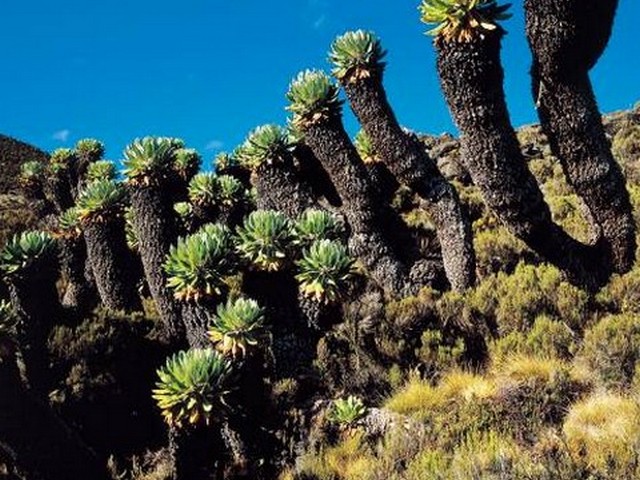Unique Plant Life on Kilimanjaro’s Shira Plateau
Nestled amidst the clouds and standing with majestic poise, Mount Kilimanjaro is not just Africa’s rooftop but also a spectacle of natural wonders, including the fascinating Shira Plateau. At the Kilimanjaro Centre for Trekking and Ecotourism (KCTE), we delve deep into the heart of Kilimanjaro’s ecological marvels, and today, we invite you on a virtual trek to explore the unique plant life that adorns the Shira Plateau. This journey is not only a trek through altitudes but also through the rare and enchanting flora that makes Kilimanjaro a botanist’s paradise.
The Enigmatic Shira Plateau
Before we embark on our botanical expedition, let’s set the stage with a brief introduction to the Shira Plateau. Positioned on Kilimanjaro’s western slope, the plateau is one of the mountain’s three volcanic cones, including Kibo and Mawenzi. At an elevation of approximately 3,900 meters, it offers a vast expanse of relatively flat land amidst an otherwise rugged terrain. The Shira Plateau is not only a stopping point for awe-inspired trekkers but also a crucial habitat for a variety of unique plant species adapted to its alpine conditions.
A Canvas of Alpine Flora
Giants of the Mountain: The Senecio Kilimanjari
As you trek across the Shira Plateau with KCTE, one of the first marvels to greet you is the impressive Senecio kilimanjari. These giant groundsel plants, endemic to Kilimanjaro, tower above the landscape, with some reaching up to 5 meters in height. Their distinctive, candelabra-like appearance is not just visually striking but also a testament to their adaptation to the harsh mountain conditions. The senecios’ thick, water-storing stems and hairy leaves minimize water loss, crucial for survival in the alpine desert climate.
Heather Gardens: The Erica Arborea Forest
Moving further, the plateau surprises with patches of Erica arborea, or the tree heather. These shrubs, reaching up to 10 meters, form dense thickets known as the "heather gardens." Flourishing in the moist conditions of the plateau, the Erica arborea is a vital part of the Kilimanjaro ecosystem, providing shelter and moisture conservation amidst the rocky terrain. Their white to light pink flowers not only add a soft hue to the plateau’s palette but also attract a variety of pollinators, ensuring the survival of this high-altitude ecosystem.
The Hardy Helichrysum
Dotting the Shira Plateau, the Helichrysum newii species adds a touch of silver to the landscape. Known for their resilience, these plants form cushion-like structures that are perfectly adapted to the cold temperatures and high UV radiation levels at this altitude. The silver-grey foliage of the Helichrysum acts as a natural sunscreen, reflecting sunlight and protecting the plant from solar radiation burns. This plant is not only a survivor but a crucial component of the plateau’s delicate ecological balance.
The Role of Adaptive Strategies
The unique plant life on Kilimanjaro’s Shira Plateau is a perfect example of ecological adaptation. Each species, from the towering senecios to the sprawling heathers and the resilient Helichrysum, has developed unique strategies to cope with the challenges posed by their environment. These adaptations include special physiological and structural traits such as water storage, reduced leaf areas, hairy leaf surfaces, and reflective foliage. These traits not only ensure their survival but also maintain the ecological integrity of the plateau.
Why Preserve This Unique Flora?
The importance of preserving the unique flora of the Shira Plateau cannot be overstated. These plants are not only crucial for maintaining the ecological balance of the region but are also indicators of environmental changes. As a leading tour operator, KCTE is committed to promoting and practicing ecotourism that helps protect these natural treasures while providing visitors with an unforgettable experience of Kilimanjaro’s natural beauty.
Visit with KCTE
Embark on a journey with the Kilimanjaro Centre for Trekking and Ecotourism to witness these botanical wonders firsthand. Our expert guides will lead you through the heart of Kilimanjaro, providing insights into the unique adaptations and ecological significance of the plateau’s flora. Booking your trek with KCTE not only promises a journey filled with awe and wonder but also supports sustainable tourism practices that help preserve Kilimanjaro’s natural heritage for future generations.
FAQ: Discover More About Kilimanjaro’s Unique Flora
What is the best time to visit the Shira Plateau to see its flora?
The best time to visit is during the dry seasons, from late June to October and from late December to early March, when the weather is more stable, and visibility is better.
Are there any specific conservation efforts in place to protect the flora on the Shira Plateau?
Yes, various conservation initiatives are implemented by local and international organizations, focusing on protecting the natural habitat and promoting sustainable tourism practices.
Can I take plant samples from the Shira Plateau?
No, removing plants or any natural material from Mount Kilimanjaro is strictly prohibited to ensure the conservation of its unique ecosystems.
In Conclusion
The Shira Plateau on Mount Kilimanjaro is more than just a scenic landscape; it is a living, breathing gallery of evolutionary art. The unique plant life here not only beautifies the mountain but also plays a crucial role in its ecological health. By choosing to trek with KCTE, you contribute to the conservation of these irreplaceable natural treasures while immersing yourself in the awe-inspiring beauty of Kilimanjaro. Join us on this botanical adventure, and be a part of our journey to keep Kilimanjaro’s legacy alive for many generations to come. Book your climbing adventure today and experience the magic of Kilimanjaro’s Shira Plateau with us!




